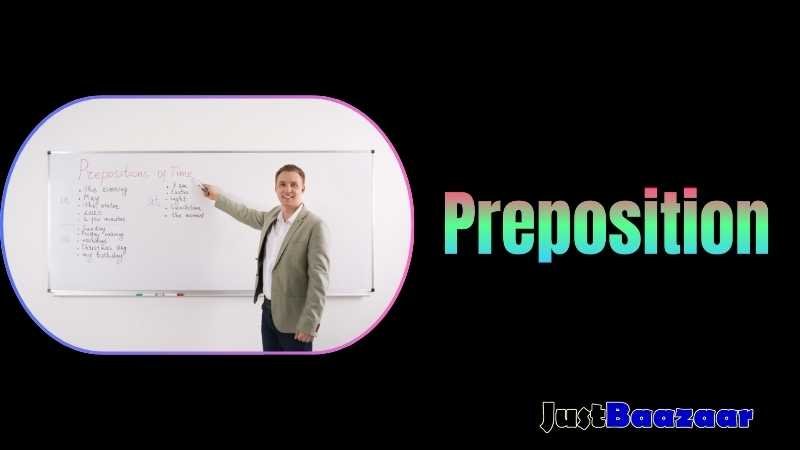What is Preposition, List of Prepositions, Examples, Easy to understand tips and tricks:

Learn How To Make Money Online – FREE Masterclass, Book Your Seat, Click HERE
CHAPTER 1: Introduction – Understanding the Basics of Prepositions
Prepositions are a fundamental part of the English language, playing a crucial role in expressing relationships between words and adding clarity to our sentences. In this chapter, we will delve into the basics of prepositions, exploring what they are and how they function.
To begin, let’s define what a preposition is. A preposition is a word that shows the relationship between a noun or pronoun and another word in the sentence. This relationship can be based on time, location, direction, possession, or other factors.
One key aspect of understanding prepositions is recognizing that they often come before nouns or pronouns to create meaningful connections within sentences. For example, consider the sentence “The book is on the table.” Here, “on” is a preposition that establishes the relationship between “book” and “table,” indicating where the book is located.
Prepositions can also form phrases when combined with other words. These phrases are known as prepositional phrases and further enhance our ability to express precise relationships within sentences. For instance, in the sentence “She walked through the park,” “through” is a preposition that forms a prepositional phrase with “the park,” describing how she moved from one side to another.
Now that we have established what prepositions are and their basic function let’s explore some common examples to gain a better understanding of their usage:
1. Time-related Prepositions:
– She arrived at noon.
– The meeting will start after lunch.
– We go for a walk every morning.
2. Location-related Prepositions:
– The cat sat on the mat.
– They live in New York City.
– The keys are under the table.
3. Direction-related Prepositions:
– He walked towards me.
– She ran away from danger.
– The plane flew over us.
4. Possession-related Prepositions:
– This book belongs to me.
– The car keys are in his pocket.
– The house with the blue door is ours.
These examples provide a glimpse into the diverse ways prepositions can be used to express relationships between words. However, it is important to note that this list is not exhaustive, and there are numerous other prepositions that exist in the English language.
As we continue our journey through this book, we will explore a comprehensive list of different types of prepositions, categorizing them based on their usage. This will enable us to understand the wide range of prepositions available and expand our ability to construct clear and meaningful sentences.
In the next chapter, we will delve deeper into these types of prepositions and provide detailed examples for each category. By familiarizing ourselves with these different types, we can enhance our understanding of how prepositions function within sentences and further refine our language skills.
The key takeaway from this chapter is that prepositions are essential components of effective communication in English. They allow us to convey relationships between words and add clarity to our sentences. By mastering the basics of preposition usage, we lay a strong foundation for navigating more complex constructions and avoiding common mistakes.
So let’s embark on this journey together as we dive into the world of prepositions. Armed with knowledge and practice, you too can become a confident user of prepositional phrases, enhancing your ability to communicate effectively and precisely.
Learn How To Make Money Online – FREE Masterclass, Book Your Seat, Click HERE
CHAPTER 2 – Types of Prepositions: A Comprehensive List
Introduction:
In the previous chapter, we explored the basics of prepositions and their role in expressing relationships between words. Now, in this chapter, we will delve into a comprehensive list of different types of prepositions. By categorizing them based on their usage and providing examples for each type, we aim to equip readers with a thorough understanding of the wide range of prepositions that exist.
Types of Prepositions:
1. Simple Prepositions:
Simple prepositions are perhaps the most common type. They consist of single words that express basic relationships between nouns or pronouns and other words in a sentence. Examples include “in,” “on,” “under,” “above,” “between,” and many others.
2. Compound Prepositions:
Compound prepositions are formed by combining two or more words to express more specific relationships between nouns or pronouns and other elements in a sentence. Examples include “according to,” “in spite of,” “out of,” and “along with.”
3. Double Prepositions:
Double prepositions are unique combinations where two simple prepositions come together to form one word that functions as a single unit within a sentence. Examples include “into,” “onto,” “within,” and “amongst.”
4. Phrasal Prepositions:
Phrasal prepositions consist of multiple words, usually including a verb followed by an adverb or adverbial particle, which together function as a single unit expressing relationships between elements in a sentence. Examples include phrases like “by means of,” “in front of,” and “with regard to.”
5. Prepositional Adverbs:
Prepositional adverbs function similarly to simple prepositions but often have additional flexibility in their placement within sentences compared to traditional prepositional phrases. Examples include words like “inside,” “outside,” “behind,” “throughout,” and “around.”
6. Prepositional Pronouns:
Prepositional pronouns are pronouns that function as compound prepositions. Examples include “beside,” “between,” “among,” and “within.”
7. Participial Prepositions:
Participial prepositions are formed by using a participle (a verb form ending in -ing or -ed) to create a preposition-like phrase that expresses a relationship between elements in a sentence. Examples include phrases like “concerning,” “regarding,” and “excluding.”
8. Disguised Prepositions:
Disguised prepositions are words that may not appear to be prepositions at first glance, but when used in certain contexts, they function as such. Examples include words like “except,” “till,” and “despite.”
Connecting Material:
As we explore the comprehensive list of different types of prepositions, it becomes clear that prepositions play an essential role in our everyday language and communication. By understanding the various types of prepositions, readers will be able to express themselves more precisely and effectively.
1. Simple Prepositions
Simple Prepositions are single-word prepositions that express basic relationships between nouns or pronouns and other words in a sentence. They convey fundamental concepts like location, direction, time, and possession. Examples include “at,” “in,” “on,” “by,” and “from.”
2. Compound Prepositions
Compound Prepositions are combinations of two or more words that express more specific relationships between nouns or pronouns and other elements in a sentence. These prepositions offer nuanced meanings and often describe complex spatial or temporal relationships. Examples include “because of,” “in spite of,” “according to,” and “next to.”
3. Double Prepositions
Double Prepositions are unique combinations involving two simple prepositions. They provide even more precise descriptions of relationships between elements in a sentence, often emphasizing direction, location, or movement. Examples include “into,” “onto,” “upon,” and “within.” Understanding these combinations enhances your grasp of English grammar and improves your writing clarity.
Learn How To Make Money Online – FREE Masterclass, Book Your Seat, Click HERE
Chapter 3: Mastering Preposition Usage: Tips and Tricks
Introduction:
In the previous chapters, we have covered the basics of prepositions and explored a comprehensive list of different types. Now, it’s time to delve into the art of mastering preposition usage. It is not uncommon for even native English speakers to struggle with choosing the right preposition in certain contexts. However, with some practical tips and tricks, you can enhance your proficiency and confidently navigate through this aspect of grammar.
Avoiding Common Pitfalls:
One common pitfall when using prepositions is confusing similar-sounding ones such as “in” and “into,” or “on” and “onto.” To overcome this challenge, it is crucial to understand the nuances between them. For example, we use “in” when something or someone is enclosed within a certain space or location, while “into” implies movement towards that space or location.
Another common mistake is incorrect word order when using prepositional phrases. It is important to remember that the preposition should always come before its object in a sentence. For instance, instead of saying “I went with my friends movies to watch,” it should be rephrased as “I went to watch movies with my friends.”
Determining Which Preposition to Use:
Choosing the correct preposition can sometimes be tricky since there are no strict rules governing their usage. However, there are some guidelines that can help you make more informed choices.
Firstly, consider the relationship between two objects or ideas in a sentence that requires a preposition. Ask yourself questions like: Is it about location? Time? Direction? Cause and effect?
Secondly, consult reliable dictionaries or grammar resources that provide examples for specific expressions. This will give you insights into commonly used combinations.
Lastly, expose yourself to authentic English materials such as books, articles, and movies where native speakers use prepositions naturally in context. Immersing yourself in the language will develop your intuition and familiarity with preposition usage.
Using Prepositions in Idiomatic Expressions:
Prepositions are often used in idiomatic expressions, where their meaning goes beyond their literal usage. For example, “get on someone’s nerves” means to irritate or annoy someone, while “fall for” means to become romantically attracted to someone. Memorizing these idiomatic expressions is a great way to expand your vocabulary and understand the versatility of prepositions.
Understanding Prepositional Phrases:
Prepositional phrases consist of a preposition and its object, along with any modifiers. They add depth and detail to sentences by providing additional information about location, time, manner, or purpose.
To master the usage of prepositional phrases, it is essential to recognize them within sentences. Pay attention to words that commonly follow prepositions such as nouns, pronouns, gerunds (-ing verbs), or even entire clauses.
Additionally, be aware that some verbs are specifically followed by certain prepositions. For example, we say “rely on,” “listen to,” or “believe in.” Familiarizing yourself with these verb-preposition combinations will greatly enhance your ability to construct grammatically correct and meaningful sentences.
Practice Makes Perfect:
As with any aspect of language learning, practice is crucial for mastering preposition usage. Create opportunities for yourself to apply what you have learned by engaging in conversations or writing exercises where you consciously incorporate prepositions correctly.
Furthermore, seek feedback from native speakers or language instructors who can provide guidance on areas where improvement is needed. Constructive criticism will help refine your skills and ensure accuracy in your language use.
Conclusion:
By utilizing the tips and tricks outlined in this chapter and practicing consistently, you can become a confident user of prepositions. Remember that mastering preposition usage takes time and effort but pays off when it comes to effective communication.
In the next chapter: “Preposition Examples: Enhancing Comprehension,” we will delve into numerous examples that demonstrate how prepositions are used in various sentence structures. Through these examples, you will gain confidence in identifying and using prepositions effectively.
Learn How To Make Money Online – FREE Masterclass, Book Your Seat, Click HERE
Chapter 4 – Preposition Examples: Enhancing Comprehension
In this chapter, we will delve deeper into the world of prepositions by providing numerous examples that demonstrate how they are used in various sentence structures. By exploring these examples, readers will gain a clearer understanding of how prepositions function and how to use them effectively in their own writing.
Before we dive into the examples, let’s briefly revisit what prepositions are and their role in expressing relationships between words. Prepositions are words that establish connections between other words in a sentence, indicating location, direction, time, manner, or other relationships. They often come before nouns or pronouns and help to clarify their relationship with other elements in the sentence.
One common type of preposition is the spatial preposition. These prepositions describe where something is located or the direction of movement. For example:
1. The book is on the table.
2. She walked across the bridge.
3. The cat jumped onto the bed.
In each of these sentences, the prepositions “on,” “across,” and “onto” indicate spatial relationships – specifically, where an object is located or where an action takes place.
Another important category of prepositions is temporal prepositions that express time-related relationships. Here are some examples:
1. I will meet you at 6 o’clock.
2. We went for a walk during lunchtime.
3. She always wakes up before sunrise.
These sentences demonstrate how temporal prepositions such as “at,” “during,” and “before” can provide information about when an event occurs or for how long it lasts.
Prepositional phrases can also modify verbs by indicating manner or method:
1. He painted with great care.
2. They sang with enthusiasm.
3. She spoke softly to avoid waking up her baby.
In these sentences, phrases like “with great care,” “with enthusiasm,” and “softly” provide additional details about how an action is performed.
Prepositions can also express relationships between people or things:
1. The gift is for you.
2. She shared her sandwich with him.
3. I am sorry about the mistake.
In these examples, the prepositions “for,” “with,” and “about” establish connections between individuals or objects.
Furthermore, prepositions are essential when discussing movement from one place to another:
1. We traveled from New York to Los Angeles.
2. He walked along the beach.
3. She ran towards the finish line.
These sentences illustrate how prepositions like “from,” “along,” and “towards” convey movement and direction in a sentence.
Additionally, prepositions can be used to describe possession or ownership:
1. The car belongs to him.
2. This house is mine.
3. The key is on my desk.
Here, the prepositions “to,” “is,” and “on” clarify who owns or possesses something.
By exploring these examples, readers can see how prepositions play a crucial role in creating precise and meaningful sentences. Understanding how different prepositions are used in various contexts will enable writers to express their thoughts more accurately and effectively.
This chapter has highlighted numerous examples of how prepositions are used in different sentence structures, showcasing their versatility and importance in communication. By studying these examples, readers can enhance their comprehension of preposition usage and gain confidence in incorporating them into their writing effortlessly. In the next chapter, we will delve even deeper into advanced topics related to preposition usage as we explore complex constructions involving multiple prepositional phrases
Learn How To Make Money Online – FREE Masterclass, Book Your Seat, Click HERE
Chapter 5: Advanced Preposition Usage: Exploring Complex Constructions
Welcome to Chapter 5 of “What is Preposition, List of Prepositions, Examples, Easy to understand tips and tricks.” In this chapter, we will delve into more advanced topics related to preposition usage. Building upon the knowledge gained from previous chapters, we will explore complex constructions involving multiple prepositional phrases and examine how nuances can be conveyed through precise choice of preposition.
Prepositions play a crucial role in expressing relationships between words in a sentence. As we progress in our understanding of prepositions, it becomes essential to explore their usage in more intricate sentence structures. By mastering advanced preposition usage, we can enhance our ability to convey precise meanings and create more sophisticated writing.
One aspect of advanced usage involves the incorporation of multiple prepositional phrases within a single sentence. These phrases work together to provide additional information or clarify relationships between different elements. Let’s consider an example:
“The book on the shelf inside the library belongs to me.”
In this sentence, we have three prepositional phrases – “on the shelf,” “inside the library,” and “belongs to.” Each phrase adds important details that help us visualize the scene described. The first phrase tells us where the book is located, while the second one specifies its position within a larger space. Finally, the third phrase establishes ownership.
By carefully selecting appropriate prepositions for each phrase, we can paint a vivid picture and convey specific information. For instance:
“The book on top of the shelf inside my favorite library belongs solely to me.”
Here, by using “on top of” instead of just “on,” we emphasize that the book occupies a prominent position within its surroundings. Similarly, by adding “my favorite” before library and using “solely” instead of just “belongs,” we express personal attachment and exclusivity.
Another aspect of advanced preposition usage involves understanding how nuanced meanings can be conveyed through precise choice of preposition. Let’s examine the following example:
“She walked towards the door.”
In this simple sentence, the preposition “towards” indicates the direction of the subject’s movement. However, by substituting it with a different preposition, such as “through,” “around,” or “past,” we can completely alter the meaning and imagery of the sentence.
“She walked through the door.” – Here, we imply that she entered a room or building.
“She walked around the door.” – This suggests that she avoided going through or entering a specific area.
“She walked past the door.” – In this case, she moved alongside or beyond the door without entering.
By carefully selecting prepositions to match our intended meaning, we can add depth and subtlety to our writing. These choices allow us to convey specific actions, emotions, and spatial relationships accurately.
As we navigate advanced preposition usage, it is crucial to be aware of common mistakes that individuals make when using or omitting prepositions. In Chapter 6, we will address these common errors and offer clear explanations on how to correct them. By understanding and avoiding these pitfalls, readers can enhance their overall proficiency in using proper grammar with respect to prepositions.
Before concluding this chapter, let’s recap what we have learned so far about advanced preposition usage. We explored how multiple prepositional phrases within a sentence can provide additional information and clarify relationships between elements. Additionally, we discussed how nuances can be conveyed through precise choice of preposition.
By harnessing these advanced techniques in our writing, we empower ourselves to create more sophisticated and precise communication. With each chapter in this book building upon previous knowledge and providing practical examples for reference and practice exercises for further reinforcement; readers are gradually becoming confident users of prepositional phrases.
In Chapter 7 – Conclusion: Becoming a Confident User of Prepositional Phrases, we will summarize the key concepts covered throughout the book and provide a final set of tips for readers to continue practicing and refining their understanding of prepositions. So, let’s keep learning and growing in our mastery of prepositions!
Learn How To Make Money Online – FREE Masterclass, Book Your Seat, Click HERE
CHAPTER 6 – Common Mistakes with Prepositions: How to Avoid Them
In this chapter, we will address common mistakes that individuals make when using or omitting prepositions. By highlighting these errors and offering clear explanations on how to correct them, readers can enhance their overall proficiency in using proper grammar with respect to prepositions. Avoiding these mistakes will not only improve your writing and speaking skills but also ensure effective communication.
1. Misusing Prepositions:
One common mistake is misusing prepositions. This occurs when a preposition is used incorrectly or inappropriately in a sentence. For example, using “on” instead of “at” when referring to a specific location or “of” instead of “for” when indicating purpose. To avoid such errors, it is important to understand the precise meaning and usage of each preposition.
2. Omitting Prepositions:
Another mistake many people make is omitting prepositions altogether. This often happens when we are in a rush or not paying close attention to our language usage. However, omitting a necessary preposition can completely change the meaning of a sentence or render it grammatically incorrect. Therefore, it’s crucial to double-check your sentences for any missing prepositions.
3 Confusing Similar-Sounding Prepositions:
Confusion between similar-sounding prepositions is another common error people make. For instance, mixing up “in” and “on,” or “at” and “to.” To overcome this confusion, it helps to remember the specific contexts in which each preposition should be used. Practice using them correctly until it becomes second nature.
4 Inconsistency in Prepositional Usage:
Consistency is key when using prepositions within the same sentence or paragraph. It can be confusing for readers if you switch between different prepositions without any apparent reason. Make sure that your choice of preposition remains consistent throughout your writing.
5 Incorrect Placement of Prepositions:
Placing prepositions at the wrong position within a sentence can also lead to misunderstandings. For example, saying “Who are you talking with?” instead of “Who are you talking to?” The correct placement of prepositions is essential for conveying the intended meaning clearly.
6 Preposition Phrases vs. Adverbs:
Another mistake to avoid is confusing preposition phrases with adverbs. Sometimes, certain words can function both as adverbs and prepositions, depending on their usage in a sentence. Understanding the distinction between these two parts of speech will help you use them correctly.
To rectify these common mistakes and improve your overall proficiency in using prepositions effectively, here are some tips and tricks:
a) Study Preposition Usage: Familiarize yourself with the different ways each preposition can be used in various contexts. Pay attention to collocations (commonly used combinations) and idiomatic expressions that involve specific prepositions.
b) Read Widely: Reading extensively exposes you to correct usage of prepositions in context. It helps develop your intuition for which preposition sounds right in a given situation.
c) Practice Writing: Regularly practice writing sentences or short paragraphs that incorporate different types of prepositions. Get feedback from others or use grammar-checking tools to identify any errors or inconsistencies.
d) Seek Clarification: If you are unsure about a particular usage or have questions about specific examples, don’t hesitate to seek clarification from reliable sources such as grammar guides or language experts.
By following these tips and avoiding common mistakes when using and omitting prepositions, you will become more confident in your ability to communicate effectively with precision and accuracy.
This chapter has highlighted common mistakes individuals make when using or omitting prepositions. We have explained how misusing or omitting a necessary preposition can lead to misunderstandings and provided strategies for avoiding such errors. By remaining consistent in your choice of preposition, paying attention to correct placement, and understanding the distinction between preposition phrases and adverbs, you can enhance your overall proficiency in using prepositions effectively. With practice and a solid understanding of preposition usage, you will become a confident user of prepositional phrases, enabling you to communicate with clarity and precision.
CHAPTER 7: Conclusion: Becoming a Confident User of Prepositional Phrases
Congratulations! You have reached the final chapter of “What is Preposition, List of Prepositions, Examples, Easy to understand tips and tricks.” Throughout this book, we have taken a deep dive into the world of prepositions, unraveling their mysteries and equipping you with the knowledge and skills to become a confident user of prepositional phrases.
In this concluding chapter, we will summarize the key concepts covered in each previous chapter and provide you with a final set of tips to further enhance your proficiency in using prepositions effectively.
Chapter 1: Introduction – Understanding the Basics of Prepositions
We started our journey by introducing you to the fundamentals of prepositions. We explored their role in expressing relationships between words and provided common examples. By understanding these basics, you gained a solid foundation for further exploration.
Chapter 2: Types of Prepositions – A Comprehensive List
In Chapter 2, we delved into an extensive list categorizing different types of prepositions based on their usage. From location prepositions like “in,” “on,” and “at” to time prepositions like “before,” “after,” and “during,” we covered them all. By familiarizing yourself with this comprehensive list, you expanded your repertoire for constructing meaningful sentences.
Chapter 3: Mastering Preposition Usage – Tips and Tricks
To help you navigate through the intricacies of using prepositions correctly, Chapter 3 offered practical tips and tricks. We discussed common pitfalls to avoid, such as confusing similar-sounding prepositions like “into” and “in.” Additionally, we provided strategies for determining which preposition to use in different contexts. Armed with these tools, you can now tackle any sentence with confidence.
Chapter 4: Preposition Examples – Enhancing Comprehension
In Chapter 4, we reinforced your understanding by presenting numerous examples that demonstrated how prepositions are used in various sentence structures. By analyzing these examples, you gained the ability to identify and use prepositions effectively. Remember, practice is key to enhancing comprehension!
Chapter 5: Advanced Preposition Usage – Exploring Complex Constructions
Building upon the knowledge gained from previous chapters, Chapter 5 explored more advanced topics related to preposition usage. We delved into complex constructions involving multiple prepositional phrases and examined how nuances can be conveyed through precise choice of preposition. By engaging with these complex structures, you honed your skills as an adept user of prepositions.
Chapter 6: Common Mistakes with Prepositions – How to Avoid Them
We addressed common mistakes individuals make when using or omitting prepositions in Chapter 6. By highlighting these errors and offering clear explanations on how to correct them, we empowered you to communicate effectively by avoiding these pitfalls. Remember, even the most seasoned writers occasionally stumble over prepositional usage, so don’t be too hard on yourself.
Now that we have summarized the key concepts covered throughout this book, let’s provide you with a final set of tips for becoming a confident user of prepositional phrases:
1. Read extensively: Reading books, articles, and other written materials exposes you to various sentence structures and their associated prepositions.
2. Practice with exercises: Engaging in grammar exercises specifically targeting preposition usage will reinforce what you’ve learned and help solidify your understanding.
3. Utilize online resources: There are numerous websites and apps available that offer interactive exercises and quizzes focused on improving your proficiency in using prepositions correctly.
4. Seek feedback from peers or professionals: Sharing your writing with others can provide valuable insights into areas where you may need improvement or clarification.
5. Be mindful of context: Consider the overall context when selecting a suitable preposition; it can greatly impact the meaning of your sentence.
6. Keep learning: The English language is vast, and there will always be new prepositions to discover. Continuously expanding your knowledge will make you an even more proficient user of prepositions.
As we conclude our journey together, remember that the mastery of prepositions takes time and practice. By consistently applying the tips and techniques provided in this book, you will become a confident communicator, expressing yourself with clarity and precision.
Thank you for joining us on this exploration of prepositions. We hope this book has been a valuable resource in demystifying the world of prepositional phrases. Now go forth and conquer the fascinating world of grammar!






